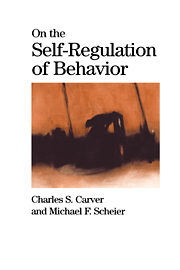Book contents
- Frontmatter
- Contents
- Preface
- Acknowledgments
- 1 Introduction and Plan
- 2 Principles of Feedback Control
- 3 Discrepancy-Reducing Feedback Processes in Behavior
- 4 Discrepancy-Enlarging Loops, and Three Further Issues
- 5 Goals and Behavior
- 6 Goals, Hierarchicality, and Behavior: Further Issues
- 7 Public and Private Aspects of the Self
- 8 Control Processes and Affect
- 9 Affect: Issues and Comparisons
- 10 Expectancies and Disengagement
- 11 Disengagement: Issues and Comparisons
- 12 Applications to Problems in Living
- 13 Hierarchicality and Problems in Living
- 14 Chaos and Dynamic Systems
- 15 Catastrophe Theory
- 16 Further Applications to Problems in Living
- 17 Is Behavior Controlled or Does It Emerge?
- 18 Goal Engagement, Life, and Death
- References
- Name Index
- Subject Index
12 - Applications to Problems in Living
Published online by Cambridge University Press: 05 June 2012
- Frontmatter
- Contents
- Preface
- Acknowledgments
- 1 Introduction and Plan
- 2 Principles of Feedback Control
- 3 Discrepancy-Reducing Feedback Processes in Behavior
- 4 Discrepancy-Enlarging Loops, and Three Further Issues
- 5 Goals and Behavior
- 6 Goals, Hierarchicality, and Behavior: Further Issues
- 7 Public and Private Aspects of the Self
- 8 Control Processes and Affect
- 9 Affect: Issues and Comparisons
- 10 Expectancies and Disengagement
- 11 Disengagement: Issues and Comparisons
- 12 Applications to Problems in Living
- 13 Hierarchicality and Problems in Living
- 14 Chaos and Dynamic Systems
- 15 Catastrophe Theory
- 16 Further Applications to Problems in Living
- 17 Is Behavior Controlled or Does It Emerge?
- 18 Goal Engagement, Life, and Death
- References
- Name Index
- Subject Index
Summary
If you don't run, you can't win.
(Chariots of Fire)You got to know when to hold 'em, know when to fold 'em.
(Don Schlitz, The Gambler)&Our main interest is in the structure and processes of normal behavior. However, any view on normal behavior also suggests ways that functioning can go awry. The conceptualization we've presented here is no exception. It suggests several angles on dysfunctional behavior, which we examine in this chapter and the next. In them we consider ways in which processes outlined earlier can go off track, leading to difficulties (for views that are related to this but also differ in some ways, see Baumeister & Heatherton, 1996; Baumeister, Heatherton, & Tice, 1994; Hamilton, Greenberg, Pyszczynski, & Cather, 1993; Kirschenbaum, 1987). In keeping with our overall strategy, we begin simply and then elaborate. The issues treated in this chapter are straightforward; Chapter 13 treats matters of greater complexity.
Some of the problems in people's lives stem from relatively simple snags in the self-regulatory process. These snags involve only the feedback loop and ways in which the effects of that loop can be disrupted. The problems are simple in structure, but not trivial in consequence.
REGULATING WITH THE WRONG FEEDBACK
Ours is a view in which people self-regulate their actions in order to keep on track in moving toward desired goals or intentions.
Information
- Type
- Chapter
- Information
- On the Self-Regulation of Behavior , pp. 217 - 233Publisher: Cambridge University PressPrint publication year: 1998
